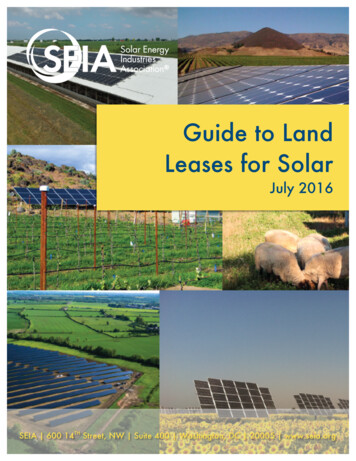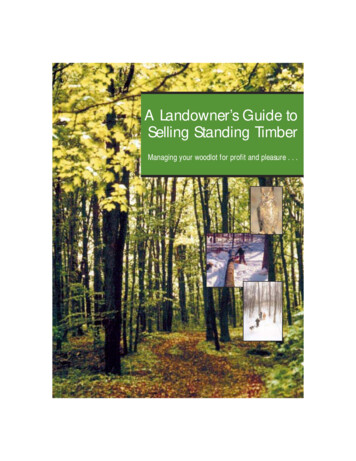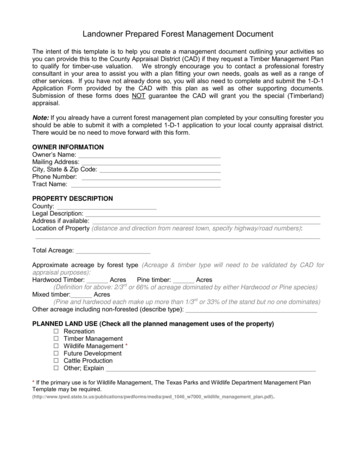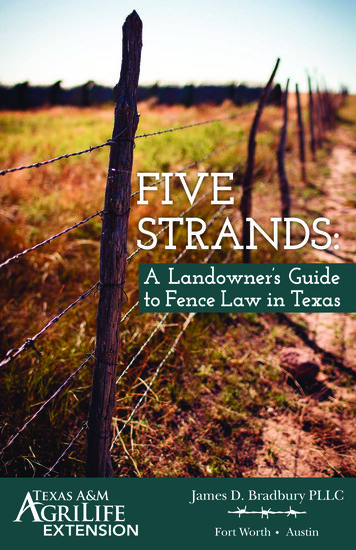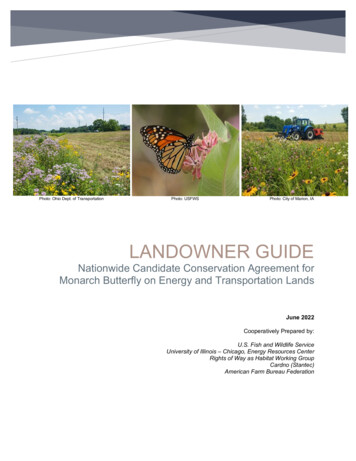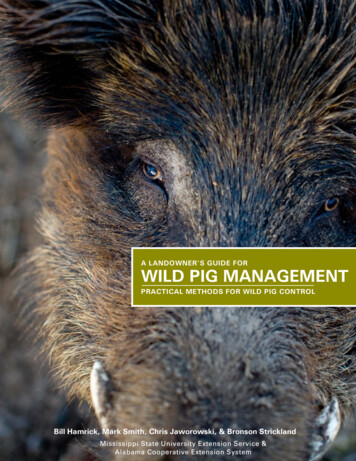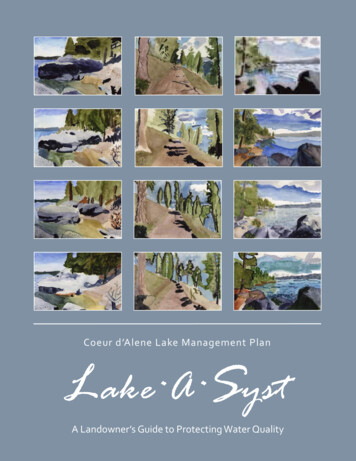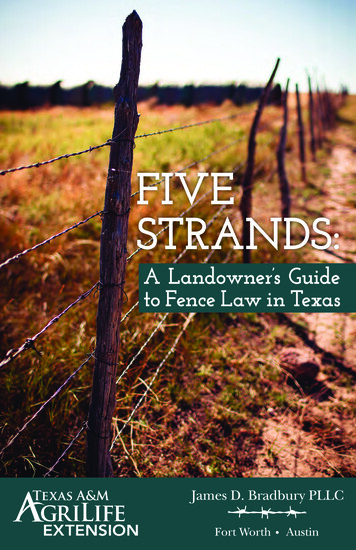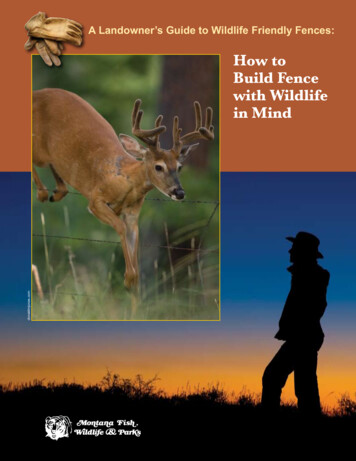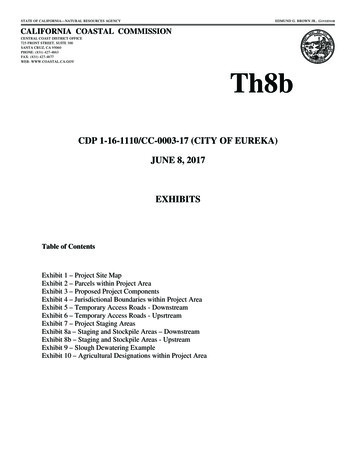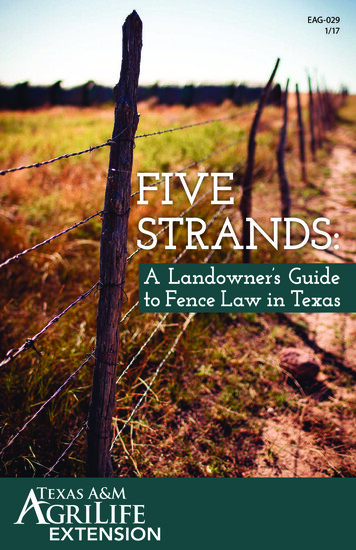
Transcription
EAG-0291/17A Landowner’s Guideto Fence Law in Texas
Tiffany D. LashmetAssistant Professorand Extension SpecialistJames D. BradburyPartner, James D. Bradbury, PLLCAustin–Fort WorthKyle K. WeldonStudent, Texas A&M University School of Law
ii
PrefaceThis book arose out of a late afternoon call from a ruralcounty in Texas. Two landowners could not agree on a fencingquestion and called the county for help. The county judgecalled us, and after a few minutes of discussion regardingthe question, we realized that Texas landowners need a fieldguide for fencing questions. The three of us work with Texaslandowners, and we get more questions about fencing thanany other topic. And, while there are thousands of miles ofbarbed wire across the state, we lack an easy-to-use resource toanswer the everyday questions that arise between landowners.Another lengthy law book would not fit in the glove box ofa pickup, so we kept this short and easy-to-follow. It maynot answer every question, but it should cover most. And,remember, the law will never substitute for an understandingbetween two neighbors over a cup of coffee.iii
iv
Table of Contentsiii Preface1 Introduction3 Liability for Livestock on the Roadway33799Open Range vs. Closed RangeLocal Stock LawsU.S. and State HighwaysLandowners and Emergency RespondersRoad/Highway Liability Examples11 Liability for Livestock on Neighboring Land111314My neighbor’s cattle are on my land.How do I remove them?Stray livestock are on my land.How do I remove them? (Estray Laws)How do the adequate fence standardsof the Agriculture Code apply?17 Responsibility for Fence Building and Maintenance1717192021Perimeter Fence between a Landownerand a State HighwayBuilding and Maintaining a Boundary Fencebetween NeighborsClearing Brush to Build a Fence on a Boundary LineCutting Down a Tree Hanging Over a Property LineAdverse Possession23 Responsibility for Fencing Around Oil and GasOperations25 Appendix: Landowner Checklist/Stock LawExamples28 Notes29 Acknowledgments30 Photo Credits
vi
IntroductionThe old saying that “good fences make good neighbors” stillapplies today. Texas has thousands of miles of fences; withthe vast majority of them located along boundary lines androadways, disputes do arise. Unfortunately, there are manymisconceptions and dead guesses about fence laws. Who isliable when vehicles on a roadway hit livestock? What are alandowner’s rights if another person’s livestock are on his orher property? Who is responsible when it comes to buildingand maintaining fences?This book gives landowners a background on how Texas fencelaws originated, explains the current laws that landownersshould know, and details a few common fence disputescenarios and solutions.1
2
Liability for Livestockon the RoadwayTo understand Texas’ current approach to fence law as itrelates to landowner liability in the event of an accident,you must first understand the concepts of open range versusclosed range.Open Range vs. Closed RangeTexas is an open-range state, tracing its roots back to the traildrives and cattle barons of the 1800s. Open range meansexactly that—livestock owners are not required to fence intheir livestock to prevent them from roaming at large. TheTexas Supreme Court supported the open-range policy morethan a century ago when it stated, “if the cattle of one personwander upon the [unenclosed] lands of another they are nottrespassers, and the owner is not liable for any damage thatthey may inflict.”1 As recently as 1999, the Texas SupremeCourt upheld this concept, holding that “[i]t is the right ofevery owner of domestic animals in this state to allow themto run at large.”2 While the common law of open range is stillin effect, there are two exceptions: 1) the passage of local,county-based ordinances (stock laws), and 2) the developmentof U.S. and state highways, that have changed large portions ofthe state from open range to closed range.Local Stock LawsAs Texas developed, laws changed and counties enactedrestrictions on open range. Such closed-range laws makelivestock owners responsible for fencing-in their livestock on3
their property. The Texas Legislature allows local governmentsto pass stock laws that modify the law for that location fromthe common-law rule of open range to closed range.3 Localvoters consider these stock laws, which can apply to all or aportion of a county. The stock laws state that certain speciesof animals (such as cattle, horses, jacks, jennies, and sheep)may not run at large within the limits of the particularcounty. When these laws are in place, the common-law ruleof closed-range law essentially replaces the common-law ruleof open range. As a result, landowners in closed-range areashave a duty to prevent their livestock from running at large,usually by maintaining a fence to keep their livestock on theirproperty.Because each local stock law is unique, the following questionsare crucial when evaluating the law in a particular county:4 Does a stock law exist in the area? Which animal species does the law cover? Did the landowner meet the required standard outlined inthe local stock law?4
Does a stock law exist in my county?Unfortunately, there is not a consolidated list that detailswhich Texas counties are still considered open range orclosed range. The best option is to contact the county sheriff’soffice or ask the county clerk to search the election recordsto determine if a local stock-option election has been heldto close the range. Since many of these stock law electionsoccurred between 1910 and 1930, it may take extensiveresearch to determine the status of your county.In 1981, the Texas Legislature exempted some counties fromadopting a local stock law regarding running cattle at large,leaving these counties as open range if the land is not adjacentto a highway (see page 8). These counties include Andrews,Coke, Culberson, Hardin, Hemphill, Hudspeth, Jasper,Jefferson, Kenedy, Kinney, La Salle, Loving, Motley, Newton,Presidio, Roberts, Schleicher, Terry, Tyler, Upton, Wharton,and Yoakum.4 For examples of stock laws, see pages 26 and 27in the Appendix.Which animal species does the law cover?If a stock law does exist in an area, determine which livestockspecies it covers. The Texas Agriculture Code allows stocklaws that regulate cattle, domestic turkeys, donkeys, goats,hogs, horses, jacks, jennets, mules, or sheep.5 Based on theparticular law, it is possible that the same area may be closedrange for horses and donkeys, but open range for cattle. Thestatute also requires separate stock laws for each livestockspecies (one for cattle, one for horses, and one for otheranimals). In an opinion issued by the Texas Attorney General,stock laws that are not separated by species may be regardedas ineffective.65
Have I met the standard outlined in the local stock law?Although they differ by county, most local stock laws establisha standard of care a landowner must meet to avoid liability ifhis or her livestock roam at large. Some stock laws state that alandowner may not “knowingly permit” an animal to run atlarge, while others set a stricter standard that animals may notrun at large at all.Many local stock laws prohibit landowners from permittingtheir animals to run at large. If a third party is injured, alandowner is liable only if he or she permitted the livestockto run free. Texas courts have interpreted “permit” to meanto expressly or “formally consent” or to “give leave,” and thatmerely making it possible for an animal to run at large isinsufficient to impose liability on a landowner. In determininga landowner’s liability for livestock roaming at large, courtslook to the owner’s actions, because an animal in theroadway does not always constitute a violation of a stock law.6
Landowner actions that might result in liability include leaving a gate open, authorizing a lessee to allow cattle to run at large, having notice that the livestock were out in the roadwayand failing to remove the livestock, having knowledge that livestock previously escaped fromthe property, and failing to maintain the fences surrounding the pasture.U.S. and State HighwaysLand along U.S. and state highways in Texas is consideredto be closed range. State law requires that landowners withproperty adjacent to U.S. and state highways prevent theirlivestock from entering these highways. Whether the area is7
open or closed range does not matter if it includes a highway.The Texas Agriculture Code states that “[a] person who ownsor has responsibility for the control of a horse, mule, donkey,cow, bull, steer, hog, sheep, or goat may not knowingly permitthe animal to traverse or roam at large, unattended, on theright-of-way of a highway.”7 To determine the scope of thisstatute, it is necessary to define what constitutes a highway, what “knowingly permit” means, and who “owns or has responsibility for the control of” theanimal.What constitutes a highway?For purposes of this statute, all U.S. and state highways areclosed range under Texas law, but farm-to-market roads areopen range unless a local stock law modifies the farm-tomarket road at issue.8What does “knowingly permit” mean?For U.S. and state highways, a landowner may not “knowinglypermit” his or her animals to run at large. This standard ishigher (more favorable to the landowner) than the standardfound in many local stock laws. For example, a court ruledthat a landowner acted knowingly when8 he was aware that the fences were unable to withstandrainfalls he knew that cattle had escaped through the weak fencesduring rainstorms many times before the accident the police had previously informed him that his cattle wereon the roadway, and he did not inspect the fences before the accident occurred.9
Conversely, a livestock owner who keeps his gate locked andchained, and has no prior knowledge of his cattle escaping ona roadway, would not act “knowingly.”10Landowners and Emergency RespondersLandowners are not liable “for damages arising from anincident or accident caused by livestock of the landownerdue to an act or omission of a firefighter or a peace officerwho has entered the landowner’s property with or withoutthe permission of the landowner, regardless of whether thedamage occurs on the landowner’s property.”11 For example,if emergency responders must cut a portion of fence alongsidea highway to put out a fire, the landowner will not be liable ifany livestock escape onto the highway.Road/Highway Liability ExamplesThe law regarding closed and open range comes into play mostoften when a vehicle strikes livestock on a roadway. In theevent of an accident, local stock laws and the statute regardingU.S. and state highways determine whether a livestock ownermay be liable to an injured motorist.9
The following examples include various scenarios ofaccidents with livestock on a roadway and the basic rules fordetermining potential livestock owner liability: 10An accident occurs in an open-range county on a U.S. orstate highway. The party that controls the livestock or realestate may be liable if the party knowingly permitted thecattle to get on the roadway.An accident occurs in a county that has adopted a stocklaw on a U.S. or state highway. The party that controls thelivestock or real estate may be liable if the party knowinglypermitted the cattle to get on the roadway.An accident occurs in an open-range county on a farmto-market road or smaller roadway. The party thatcontrols the livestock or real estate has no duty to preventlivestock from entering the roadway by their naturalbehavior.An accident occurs in a county that has adopted a stock lawon a farm-to-market road or smaller roadway. The partythat controls the livestock or real estate may be liable if theparty negligently permitted the cattle to get on the highway.12
Liability for Livestockon Neighboring LandIn addition to disputes between landowners and motoristsregarding livestock and fences, questions often arise betweenneighboring landowners regarding the obligations they oweone another concerning fences and livestock.My neighbor’s cattle are on my land.How do I remove them?The answer depends on whether this situation occurs inan open-range county or in one that has passed a stock lawmaking it a closed range.Open RangeIn an open-range county, the landowner is responsiblefor keeping livestock off his or her land by building anadequate fence. According to the Texas Supreme Court,“[i]t follows that one who desires to secure his lands againstthe encroachments of livestock running at large, either uponthe open range or in an adjoining field or pasture, must throwaround it an [enclosure] sufficient to prevent the entry of allordinary animals of the class intended to be excluded. If hedoes not, the owner of animals that may encroach upon itwill not be held liable for any damage that may result fromsuch encroachment.”13 However, the defense that a landownerfailed to maintain a suitable fence is likely unavailable in anaction for trespass where it appears that the livestock ownerintentionally allowed the livestock to enter the property.14 Inan open-range county, if a landowner has built an adequatefence and livestock still get onto his or her property, the11
landowner can recover crop or property damages from theanimal’s owner. On the other hand, if a landowner fails tobuild an adequate fence in an open-range county, he or shehas no recourse against a livestock owner when animals enterhis or her property.Closed RangeIn a county that has passed a stock law (making it a closedrange), livestock owners must restrain their livestock byfencing them “in” their property. Allowing livestock (thatare covered by the stock law) to run at large in a closed-rangecounty is a violation of the law. Nevertheless, the grass doestend to be greener on the other side and livestock may get outon occasion. Understanding this, the Texas Supreme Courtexplained that sometimes, “animals may often escape withoutfault on the part of their owners, when the latter will be guiltyof no offense against the law.the mere fact that an animalis at large is not necessarily a violation.”15 In most cases, thelivestock that have escaped and entered your land are thereby accident. Notifying your neighbor and helping him or herretrieve the livestock off your property is the best course ofaction. But, if the neighboring livestock owner has permittedthe livestock to enter your property, depending on what thelaws of your county are, he or she could be breaking the law.Because some counties do not have stock laws containing the“knowingly permit” or “permit” language when describingthe intent of livestock owners, it is important to understandthe law of your county.In a closed-range county, a landowner may be able to recoverdamages from a livestock owner whose animals come ontothe landowner’s property if the livestock owner failed to meetthe requirements of the closed-range county. However, if thelivestock owner met the requirements, and the livestock stillgot out, the landowner may be unable to seek recovery underthe law.12
Lessee LiabilityMany Texas livestock producers lease the land they they runtheir livestock on. This presents a question of who is responsiblefor fencing the land the livestock run on–the landowner or thelessee? Absent an agreement allocating responsibility betweenthe landowner and the lessee, these laws could apply to both thelandowner and the lessee who runs the livestock on a ranch.Stray livestock are on my land.How do I remove them? (Estray Laws)Under Chapter 142 of the Texas Agriculture Code, alandowner who finds stray or “estray” livestock on his or herproperty should “as soon as reasonably possible, report thepresence of the estray to the sheriff of the county in which theestray is discovered.”16 Providing the location, number, and adescription of the stray livestock helps the sheriff’s office findthe true owner and remove the livestock from your property.Once stray livestock are reported, the sheriff will attemptto contact the owner. If the owner is found, he or she mayrecover the livestock in accordance with the procedures setforth by statute. If an owner is not found or fails to redeem the13
livestock within 5 days, the sheriff will impound the animal. Ifthe animal is not recovered from impound, the sheriff will sellthe animal at public auction.Just because stray livestock are on one’s land does not meanthe landowner can automatically claim them or removethem by other methods. Disposing of estrays outside of theprocedure in Chapter 142 may be considered livestock theft.How do the adequate fence standardsof the Agriculture Code apply?The Texas Agriculture Code establishes the requirementsfor a “sufficient fence;” however, these fencing standardsapply only in open-range counties where fences are meant tokeep livestock “out” rather than “in.”17 These sufficient fencestandards do not apply in a closed-range county, nor canthey be used to determine negligence or liability in a roadwayaccident situation.14
In an open-range county, it is the landowner’s duty to buildfences that keep animals permitted to roam at large off theirproperty. The fence standard in the Ag Code determines if alandowner who built a fence to keep livestock off his or herproperty can recover property or crop damage from an animal’sowner if the animal got onto the landowner’s property.Section 143.028 provides the following guidelines:(a) A person is not required to fence against animals that arenot permitted to run at large. Except as otherwise provided bythis section, a fence is sufficient for purposes of this chapter if itis sufficient to keep out ordinary livestock permitted to run atlarge.(b) In order to be sufficient, a fence must be at least four feethigh and comply with the following requirements:1. A barbed wire fence must consist of three wires on posts nomore than 30 feet apart, with one or more stays betweenevery two posts;2. A picket fence must consist of pickets that are not more thansix inches apart;3. A board fence must consist of three boards not less than fiveinches wide and one inch thick; and4. A rail fence must consist of four rails.1815
16
Responsibility for FenceBuilding and MaintenanceHaving an accurate survey that shows the correct boundary lineis paramount when building boundary fences. Without a surveyshowing where property lines end and begin, fence building isan inaccurate guess and could lead to future headaches.Perimeter Fence betweena Landowner and a State HighwayIn Texas, all interstate and state highways are closed range.The Texas Agriculture Code states “[a] person who owns orhas responsibility for the control of a horse, mule, donkey,cow, bull, steer, hog, sheep, or goat may not knowinglypermit the animal to traverse or roam at large, unattended,on the right-of-way of a highway.”19 To keep livestock offof interstates and state highways, it is the landowner’sresponsibility to build/maintain a fence along an interstateor state highway. However, if a landowner does not intendto have any livestock on his or her property, there is noindependent obligation to build a fence.Building and Maintaininga Boundary Fence between NeighborsFrequently, questions arise regarding how neighboringlandowners must share in the costs of building andmaintaining boundary fences.A landowner in Texas has no legal obligation to share in thecosts or future maintenance of a fence built by his or her17
neighbor on the dividing property line, unless he or she hasagreed to do so. The Texas Supreme Court has held that, “ifone proprietor [encloses] his land, putting his fence upon hisline, the owner of the adjacent land may avail himself of theadvantage thereby afforded him of [enclosing] his own landwithout incurring any liability to account for the use of hisneighbor’s fence.”20 Even if a boundary fence is destroyed bynatural causes, a neighbor still has no obligation to contributetoward its reconstruction.21 However, if the neighboringlandowner does not participate in the costs of erecting the fence,it is not considered a common fence; rather, it is the exclusiveproperty of the builder.22 Similarly, if a fence is built not on theproperty line, but instead on one landowner’s property, then thefence is also considered exclusive property of that landowner.If the neighbors agree that each will maintain a portion of thefence, such agreement is legally binding and can be enforced.2318
These agreements are rare, but may be extremely useful forneighboring landowners to specify their rights and obligationsregarding fences before an issue arises. Once neighbors reacha friendly agreement, it should be written down and a copygiven to each owner.Clearing Brush to Build a Fenceon a Boundary LineSometimes a landowner building a fence along a boundaryline must clear brush on both his or her own property andthe neighbor’s property. If this is necessary, the landownershould always seek permission from the neighbor beforeentering his or her property and before clearing any brush.Without such permission, entering a neighbor’s property19
and removing the brush could be considered trespassing andsubject the acting landowner to damages. It is always betterto ask for permission ahead of time. If permission is denied,the landowner may have to back the fence up on his or herproperty.Cutting Down a Tree Hangingover a Property LineAssume that a tree grows on the neighbor’s property, but thelimbs and branches overhang another’s land. What rightsdo the parties have in that situation? In Texas, the locationof the trunk of the tree determines who owns it, even if theroots or branches grow onto an adjoining neighbor’s land.A landowner has the right to trim or cut off the limbs orbranches of boundary trees or shrubbery that reach onto hisor her property, as long as no damage to the other adjoininglandowner occurs. However, the limbs or branches can be cutback only to the property line. The tree’s owner is responsiblefor any damages caused to the adjacent owner from fallingbranches or roots. It is in the best interest of the tree’s ownerto control the growth of the tree so it does not create a sourceof potential damage to the neighboring landowner.20
Adverse PossessionAdverse possession, commonly referred to as squatters’ rights,is a legal concept that concerns many Texas landowners. Therisk of adverse possession encourages landowners to makeregular use of and inspect their property. Otherwise, anadverse possessor (squatter) can claim title to the land if anumber of conditions are met. It is very difficult in Texas totake someone’s land by adverse possession. Although rare, thissituation may arise periodically in the context of fencing.For example, assume that a landowner’s fence is just inside hisproperty line and his neighbor grazes livestock on the few feetof land belonging to the landowner, but not included withinthe fenced-in area. While that land does not technicallybelong to the neighbor who is using it, if several factors aremet, the neighboring landowner may actually be able to seektitle to that property.In order for someone to lawfully gain possession of land byadverse possession, there must be a visible appropriation and possession of the property, that is open and notorious, peaceable,21
under a claim of right, adverse and hostile to the claim of the owner, and consistent and continuous for the duration of the statutoryperiod.24Each of these elements requires in-depth legal analysis beyondthe scope of this handbook to determine if they exist in aparticular case. The key element a neighbor using another’s landwould have to prove is the “under a claim of right” element.The neighboring landowner needs to “designedly enclose” theproperty for his or her own use in order to adequately givenotice to the record owner of the hostile claim.25Using a boundary fence line example, if Neighbor A buildshis fence inside his property line, Neighbor B’s cattleoccasionally grazing on the land is not going to be enough togain title. However, if Neighbor B builds his own fence justoutside the current fence (and on the property of NeighborA), that is more likely to be the sort of evidence that couldbe used to show that Neighbor A had sufficient notice thatNeighbor B was staking a hostile claim to that strip of land.Simply grazing livestock on your land is not enough to gainpossession by adverse possession.26A good practice if you have to build a fence inside your ownboundary is to write your neighbor and let him or her knowthat you still intend to use your property to the boundary andconsider filing a record of this fact in the real property recordsof your county.22
Responsibility for FencingAround Oil and Gas OperationsIn Texas, oil and gas companies have the right to enter privateproperty and locate their production facilities under the“reasonable right to use the surface.” Oil and gas companiesare under no legal obligation to place a fence around theiroperations areas in order to protect a surface owner’slivestock. The mineral estate is dominant to the surface estate,meaning that a mineral owner or lessee has the implied rightto use as much of the surface as is reasonably necessary toproduce the minerals, without permission from or payment tothe surface owner. “In the absence of a lease provision to thecontrary, the only duty owed by the operator of an oil lease tothe owner or lessee of the surface, who is pasturing cattle, isnot to injure such cattle intentionally, willfully, or wantonly.There is no duty on the part of an operator to put fencesaround his operations.”27If livestock are injured, a landowner may have legal claims ifthere is evidence that the oil and gas operator acted in an intentional, willful, or wanton manner toinjure the livestock; acted negligently in producing the minerals; or used more of the surface than was reasonably necessary.However, because each of these claims will likely be difficult toprove, the landowner is much better off to include contractualprovisions that require the operator to fence off operations toprotect livestock (ideally in the oil and gas lease itself). In theabsence of a lease provision, communication with the oil andgas operator is key and likely the best course. The operatormay be willing to put up a fence around its facilities in orderto avoid potential liability.23
24
AppendixLandowner Maintenance Checklist Inspect and repair fences regularly. Check livestock frequently to be sure none have escaped. Get to know your neighbors. In case of emergency, share your contact information withneighbors and county officials (sheriff).Stock Law ExamplesThe following examples are local stock laws passed in HuntCounty, Texas, in 1907. These laws were often handwrittenand included in the minutes of commissioner’s court meetingsheld nearly a century ago. Unfortunately, there is no publishedcompilation or other way to quickly and efficiently look upTexas stock laws.25
Hunt County Stock LawCourtesy of Hunt County Courthouse, Greenville, Texas26
Hunt County Stock Law of 1882 for Sheep, Goats, and HogsCourtesy of Hunt County Courthouse, Greenville, Texas27
NotesClarendon Land, Investment & Agency Co. v. McClelland, 23 S.W.576, 577 (Tex. 1893).2Gibbs v. Jackson, 990 S.W.2d 745, 747 (Tex. 1999).3TEX. AGRIC. CODE ANN. §§ 143.021–082. (West, Westlaw through2015 Reg. Sess).4TEX. AGRIC. CODE ANN. §§ 143.072.5Id.6Texas Att’y General Opinion No. GA-0093 (2003).7TEX. AGRIC. CODE ANN. § 143.102. (West, Westlaw through 2015Reg. Sess).8TEX. AGRIC. CODE ANN. § 143.101. (West, Westlaw through 2015Reg. Sess).9Weaver v. Brink, 613 S.W.2d 581, 583-84 (Tex. App.—Waco 1981, writref’d n.r.e.).10Evans v. Hendrix, No. 10-10-00356-CV, 2011 WL 3621337 (Tex.App.—Waco, Aug.17, 2011) (mem. op).11TEX. CIV. PRAC. & REM. CODE ANN. § 75.006(b). (West, Westlawthrough 2015 Reg. Sess).12Lebas, David & Huffaker, John, Agricultural Law: Where’s the Beef?Legal Issues in the Texas Cattle Industry, 73 Tex. B.j. 400 (May 2010).13Clarendon Land, Investment & Agency Co. v. McClelland, 23 S.W.576, 577 (Tex. 1893).14Posey v. Coleman, 133 S.W. 937, 939 (Tex. Civ. App. 1911).15Tex. & Pac. Ry. Co. v. Webb, 114 S.W. 1171, 1173 (Tex. 1908).16TEX. AGRIC. CODE ANN. § 142.003(a). (West, Westlaw through2015 Reg. Sess).17TEX. AGRIC. CODE ANN. § 143.028. (West, Westlaw through 2015Reg. Sess).18Id.19TEX. AGRIC. CODE. ANN. §143.102. (West, Westlaw through 2015Reg. Sess).20Nolan v. Mendere, 14 S.W. 167, 168 (Tex. 1890).21Griffin v. Sansom, 72 S.W. 864, 864 (Tex. Civ. App. 1903).22Conner v. Joy, 150 S.W. 485, 485 (Tex. Civ. App.—Fort Worth 1912, nowrit).23Adair v. Stallings, 165 S.W. 140, 141-42 (Tex. Civ. App.—Amarillo1914, writ dism’d).128
Statutory periods vary with the claim (anywhere between 10 and 25years)25McDonnold v. Weinacht, 465 S.W.2d 136, 144 (Tex. 1987).26Perkins v. McGehee, 133 S.W.3d 287, 292 (Tex. App.—Fort Worth2004, no pet.).27Santana Oil Co. v. Henderson, 855 S.W.2d 888, 889-90 (Tex. App.—ElPaso 1993, no pet.).24AcknowledgmentsThe authors gratefully acknowledge the invaluable assistanceof Ms. Amber Miller of Crenshaw Dupree & Milam, L.L.P. inLubbock, and Mr. James Decker of Shahan Guevara Decker& Arrot in Stamford, who provided innumerable insights intothe subject matter of this handbook and reviewed its contents.The authors would also like to thank Britt Fisk and ConnieLoveland for their willingness to share their outstandingphotographs with us.29
Photo CreditsBritt Fisk, Britt Fisk Photography – front and back coversKay Ledbetter, Texas A&M AgriLife Communications – page 9Connie Loveland, C. Loveland Photography – pages 14, 21, 29Pexels – page 10Pixabay – pages i, iii, v, vii, 2, 4, 6–7, 13, 16, 18–19, 20, 22, 24, 30Adam Russell, Texas A&M AgriLife Communications – page 1530
The information given herein is for educational purposes only. The Texas A&M AgriLif
This book arose out of a late afternoon call from a rural county in Texas. Two landowners could not agree on a fencing question and called the county for help. The county judge called us, and after a few minutes of discussion regarding the question, we realized that Texas landowners need a field guide for fencing questions.
